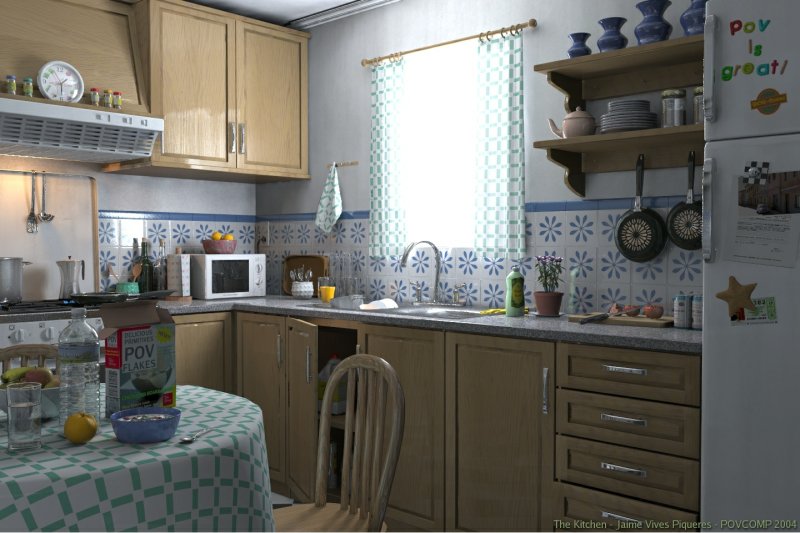I started with classic CSG for the room and the furniture, and also for the first objects. But soon I noticed that it will take me ages to complete all the planed scenery with CSG only, so I started to use Wings3D to model more quickly some objects or parts of CSG objects. As a Wings3D newbie, this was a great learning experience, as I had to model many kinds of objects. But my skills at it were not enough to model some very typical kitchen objects, wich I hope you will not notice as missing.
At the end, I used a lot of meshes, but also much CSG with basic primitives, some height_fields and few other primitives like lathes, superellipsoids or simple isosurfaces. Almost all the objects were created for this scene, although a few are old objects of mine (but all them enhanced for the occasion). There are no third party models on the scene, but the picture on the fridge door shows another scene of mine wich contains the Mini-Cooper model by Gilles Tran.
The textures are almost all procedural (including the tiles and cloth patterns), mostly POV-Ray standard textures with aditional layers or little modifications to add variable reflection and micro-normals, with the exceptions of the walls texture, the banana skin, and of course all the labels and other prints, wich were handpainted by me with The Gimp. The images for the papper and the lottery ticket on the fridge door, and the vegetables on the clock, are scanned images. Some textures use uv mapping, as the tablecloth, the curtains and the banana, with automatic uv info generated with Wings3D.
Emitting media was used on the window glass sheets to simulate an overexposed outside, and also on the kitchen fire. The curtains and the milk have scattering/absorption media inside, but in the milk it was poorly adjusted.
The lighting is tricky, as it is not pure radiosity coming from the outside through the window. Actually, there are 4 area lights, one on each glass sheet, facing to the inside using spotlight with cosine fallof. These area lights, plus the kitchen light, cast the main soft shadows, and generate the interior radiosity with only one bounce.
The radiosity data was saved in a first-pass render with plain textures and withouth area light nor antialiasing, at 720x480. This precalculated data was copied along with the scene on my 2 computers to distribute the render. The computers where an AMD XP 2,01Ghz and an AMD Athlon 1,2Ghz, both running Fedora Core 2 Linux. The final render at 1440x960 took 154 hours and 18 minutes, using +A0.0 +R4 for the antialiasing.
The detail views are not really interesting or useful. I had to do so because the rendering times on these views were longer than I expected, much longer than the main image itself, due to the many slow features I used together: radiosity, area_lights, glass, micro-normals, media. So I used the histogram output as help to find the parts of the image wich rendered faster, and used not so heavy antialias settings. Sorry if this seems a bit like cheating or twisting the rules too much, but I had no other choice due to the high requirements of the detail views in my case...
All the scene code typing was done with VIM (vi improved), except for the meshes generated by Wings3D, managed with Gedit more easily. I've searched a lot on Internet for pictures of kitchens and related objects, using Google and Mozilla. I surely forgot a lot of things to explain, but everyone is free to ask (or to wait for a detailed "Making of" on my web site, which will include the source code).
|




